- Quick Read
- Deep Read ( 5 Min. )

Why is Christian Science in our name?
Our name is about honesty. The Monitor is owned by The Christian Science Church, and we’ve always been transparent about that.
The Church publishes the Monitor because it sees good journalism as vital to progress in the world. Since 1908, we’ve aimed “to injure no man, but to bless all mankind,” as our founder, Mary Baker Eddy, put it.
Here, you’ll find award-winning journalism not driven by commercial influences – a news organization that takes seriously its mission to uplift the world by seeking solutions and finding reasons for credible hope.
Explore values journalism About usMonitor Daily Podcast
- Follow us:
- Apple Podcasts
- Spotify
- RSS Feed
- Download
TODAY’S INTRO
Two big statements for women’s soccer
 Mark Sappenfield
Mark Sappenfield
This week, soccer made two big statements about women coaches. The rather larger one happened in the United States, where the women’s national team landed Emma Hayes. Her Chelsea team has become the dominant force in the English Women’s Super League. She will be the soccer world’s highest-paid women’s coach – equal to the U.S. men’s coach.
Somewhat smaller, but closer to home (for me), my adopted hometown club, Union Berlin, has hired Marie-Louise Eta as an assistant. She will be the first woman to coach in Germany’s top men’s league. We’ve written on the trend before. Signs suggest it’s just getting started.
Share this article
Link copied.

Help fund Monitor journalism for $11/ month
Already a subscriber? Login

Monitor journalism changes lives because we open that too-small box that most people think they live in. We believe news can and should expand a sense of identity and possibility beyond narrow conventional expectations.
Our work isn't possible without your support.
Amid slog of Ukraine war, NATO turns warier eye on Russia
Much of the Daily today looks at the world’s shifting tides. How is conflict – or the threat of it – altering the ties between allies and adversaries? We start in Europe, where the Ukraine war is changing the ways a reawakened NATO prepares for war. A recent war game offers clues.

NATO last month conducted a computerized war-game exercise that was notable for more than just its scale and complexity. What particularly stood out was the way the alliance made clear that it was squaring off against a Russia that would not stop, despite deterrence efforts.
Since the exercise was a war game, Russia was given a different name, but for the first time, NATO officials were using real-world geographical data and targeting coordinates, identifying the adversary in all but name.
This was a step many member nations wouldn’t entertain prior to Russia’s February 2022 invasion of Ukraine. It was too inflammatory, the thinking went.
“We cannot explore and address the shortfalls, the problems, the challenges in exercises if we don’t have real-world geo-data,” says Brig. Gen. Gunnar Bruegner, assistant chief of staff for collective training and exercises at NATO Supreme Allied Headquarters Europe. “It’s as simple as that.”
Next year, NATO will build on this effort by holding its largest live exercise since the Cold War, to include tens of thousands of troops.
The exercises, all told, are a clear indication of the ways in which Russian President Vladimir Putin’s war in Ukraine is transforming how NATO is preparing to fight.
Amid slog of Ukraine war, NATO turns warier eye on Russia

NATO last month conducted a computerized war-game exercise that was notable for more than just its scale and complexity.
What particularly stood out was the way in which the alliance wanted to make it very clear that it was squaring off against a Russia that would not stop, despite some herculean deterrence efforts.
Since the exercise was a war game, Russia was given a different name, but for the first time, NATO officials were using real-world geographical data and targeting coordinates – a move that identified the adversary in all but name.
This was a step many member nations wouldn’t entertain prior to Russia’s February 2022 invasion of Ukraine. It was too inflammatory, the thinking went.
Yet today the desire to practice targeting Russia – because of a growing concern that it might one day be necessary – has increased considerably among alliance members.
“We cannot explore and address the shortfalls, the problems, the challenges in exercises if we don’t have real-world geo-data,” says Brig. Gen. Gunnar Bruegner, assistant chief of staff for collective training and exercises at NATO Supreme Allied Headquarters Europe. “It’s as simple as that.”
Next year, NATO will build on this effort by holding its largest live exercise since the Cold War, to include tens of thousands of troops, hundreds of air combat missions, and a trans-Atlantic crossing of U.S. military warships.
The exercises, all told, are a clear indication of the ways in which Russian President Vladimir Putin’s war in Ukraine is transforming how NATO is preparing to fight.
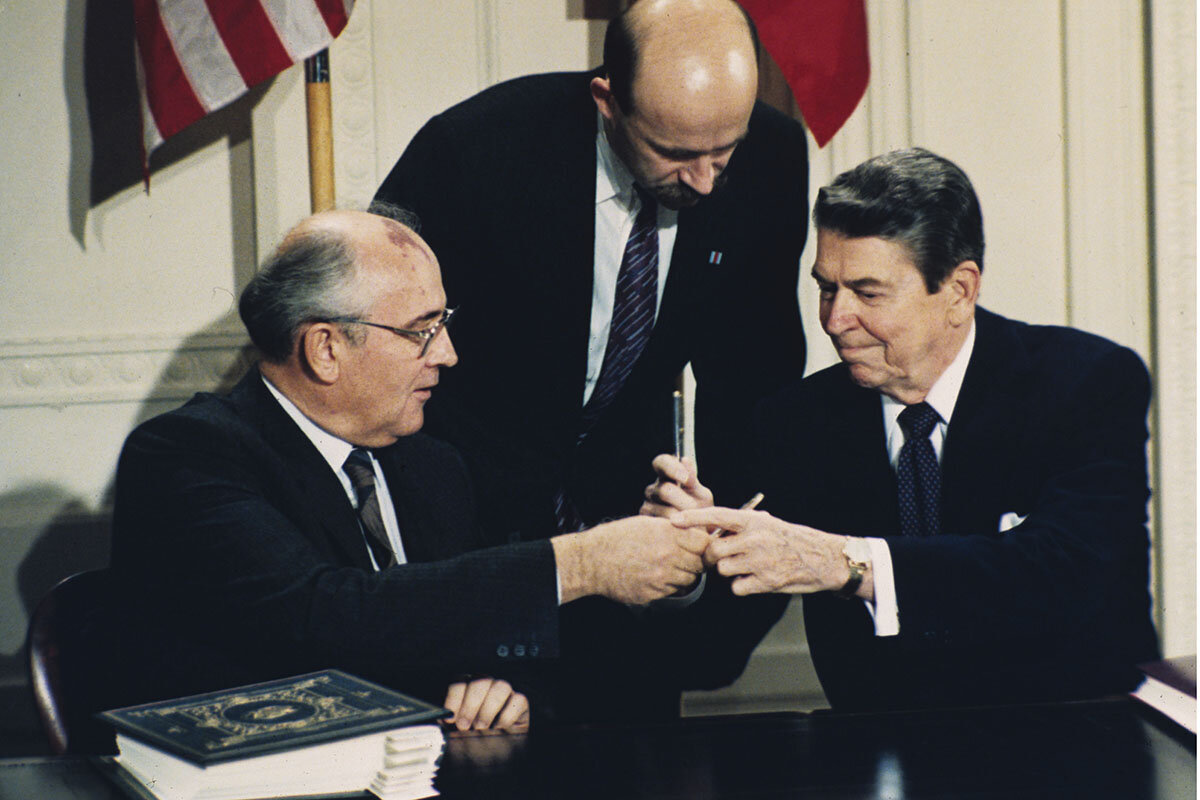
While the war in Ukraine is an unequivocal tragedy, it has forced NATO members to pool resources and prepare for battle in a way they never have – and never were inclined to do – before, a senior NATO military official says: “This is a significant step forward.”
Enough resources to go around?
Officials here say they need to grapple with the reality of competing priorities among alliance members. One example: The war game last month explored what happens when, with battles looming, NATO members choose “to keep something back for their own defense purposes” rather than give it to NATO to use somewhere other than their own backyard, the senior military official notes.
In this way, some members “had to realize that their preparedness, the response that they were able to provide ... was not big enough.”
One of the aims of the exercise, after all, was to test, against a “mighty” adversary, how long NATO forces and supplies in different regions will be able hold their lines in an onslaught, and “how best to manage until the reinforcements come,” the official adds.
The war game also illustrates that NATO planners have their eyes on the risk of battlefield catastrophe.
It’s a prudent position. President Putin’s decision earlier this month to pull out of a landmark security pact that had long restricted the use of conventional weapons has raised some alarms among defense analysts.
That came less than a week after Moscow revoked the country’s ratification of the Comprehensive Nuclear-Test-Ban Treaty, which outlaws nuclear weapons tests. Russia then promptly put an intercontinental ballistic missile through its paces.
On the ground in Ukraine, the Kremlin has been replenishing its missile stockpiles considerably more quickly than Western nations had anticipated, according to a recent analysis from the Institute for the Study of War.
“The Russian defense industry is turning out tanks, artillery, munitions 24/7, 365 days a year. And this is not something where NATO has caught up yet,” says Rafael Loss, coordinator for pan-European data projects at the European Council on Foreign Relations.
At the same time, even as they continue to send weapons and military supplies to Ukraine, NATO countries “are investing significantly into rebuilding their forces,” Mr. Loss notes. “And sometimes those two goals are competing.”
Increasingly, the news out of Ukraine seems to indicate that, as the country’s top military commander told The Economist earlier this month, “there will most likely be no deep and beautiful breakthrough” in Kyiv’s current counteroffensive.
In Ukraine, both sides face difficulties
Still, Russia is struggling with the current stalemate in Ukraine as well.
Igor Girkin, a former security agent-turned-ultranationalist critic of Mr. Putin’s conduct of the war – he called it “too kind” – recently lamented that by spring of 2024, Russian forces will be “even less capable of offensive operations than they are now.”
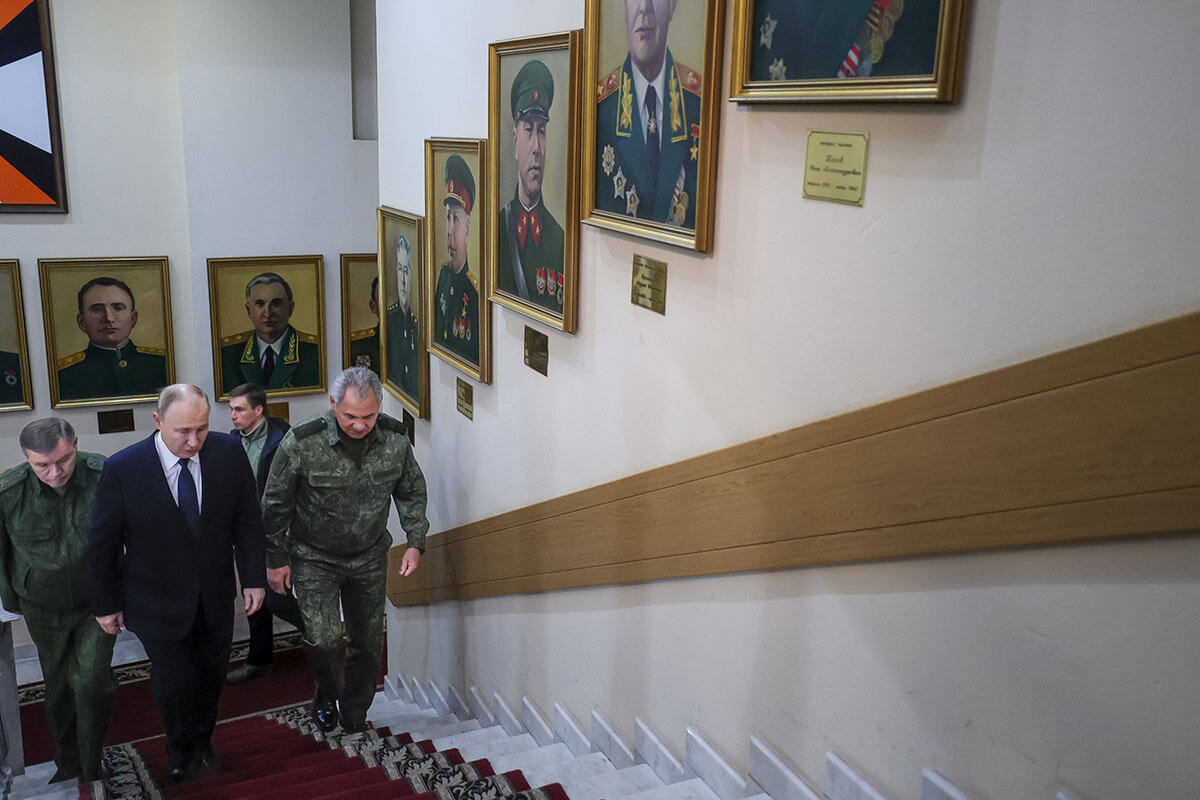
Mr. Girkin, who has also said that Western military aid could allow Ukraine to conduct successful offensive operations in 2024, is now sitting in a Russian jail for his critiques. (Separately, he was convicted in absentia earlier this year by a Dutch court in the 2014 downing of a Malaysian passenger jet over Ukraine.)
In the years before Mr. Putin’s invasion, the expectation among American defense officials was that the Russian military was in very good shape.
In a discussion earlier this month, Lt. Gen. Scott Barrier, a career intelligence officer and now director of the U.S. Defense Intelligence Agency, said the fact that this is not the case has been the biggest surprise of the war.
The agency’s job is to analyze foreign armies. “Having intimate understanding of militaries is really where we’re supposed to be,” he said.
Even so, “our preconceived notions about what the Russian military was turned out not to be true,” Lieutenant General Barrier told an audience at the Center for Strategic and International Studies.
“Honestly, through years of counterterrorism analysis and operations, we kind of took our eye off the ball,” he said.
Still, good military strategists know never to underestimate an adversary. While Russia may be weakened now, it is estimated that Moscow will be able to reconstitute its military “roughly six to 10 years” post-Ukraine, Mr. Loss says. “That is not a very long timeline.”
NATO’s Steadfast Defender exercise early next year is expected to involve roughly 41,000 NATO forces, some 700 air combat missions, the breaching of a Polish river – which NATO officials note is trickier than it sounds – and more than 50 vessels, including the trans-Atlantic crossing of U.S. warships.
The hope is that all this will reinforce NATO admonitions to Russia to stop the aggression.
“Every ship that sails, every aircraft that flies, every tank that rolls,” Brigadier General Bruegner says, “is sending a message.”

Israel’s dilemma in confronting threat from Hezbollah
In the Middle East, Israel has been loath to open a second front against Hezbollah. The United States is strongly against widening the war. But fighting has already displaced thousands of Israelis from their homes in the north. Can they return with Hezbollah just over the border?
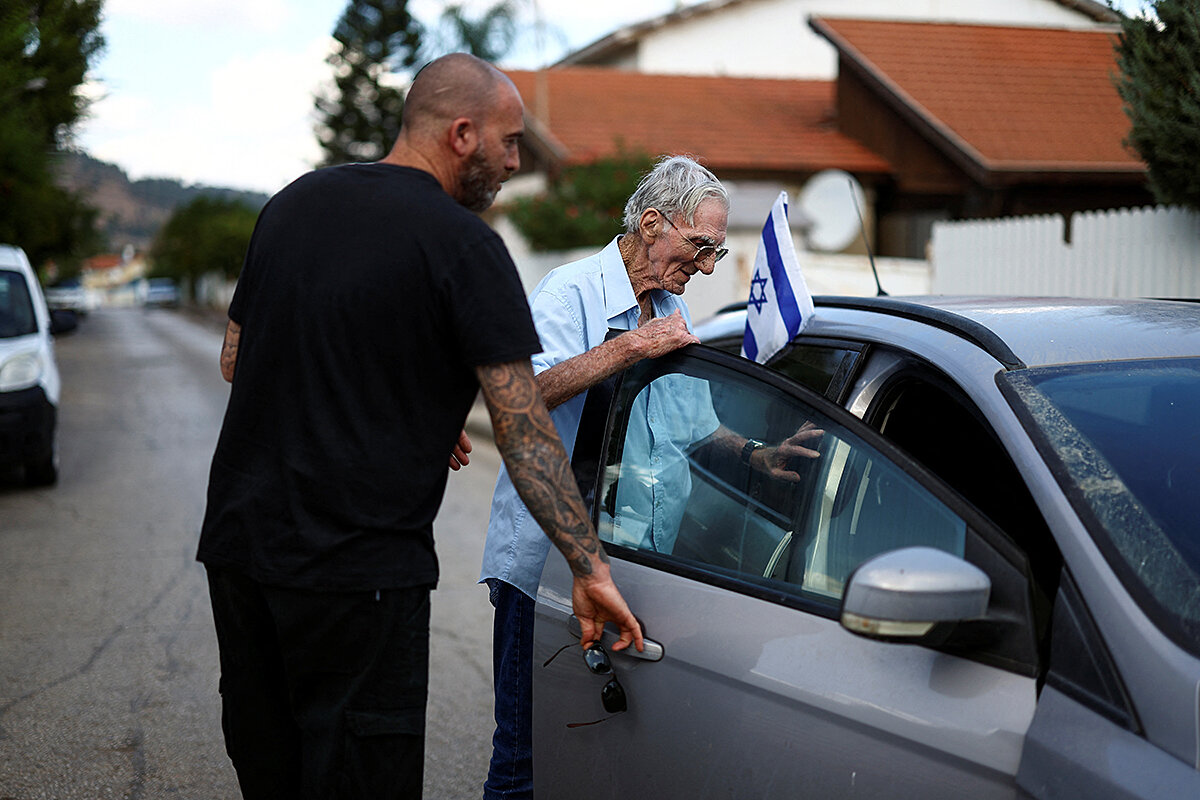
- Quick Read
- Deep Read ( 5 Min. )
-
By Neri Zilber Contributor
Kiryat Shmona, in Israel’s far north, is a ghost town. Only a fraction of the city’s 24,000 residents remain, and the sounds of artillery, missiles, and drones fill the air constantly. The siren alerting residents to incoming fire goes off almost at the same instant as the impact, so close is the town to the Lebanese border and Hezbollah militiamen.
Hezbollah’s presence has long posed a threat to Israelis in the north. But the current hostilities – rockets and anti-tank missiles fired by Hezbollah, and retaliatory Israeli drone or artillery strikes – constitute the heaviest fighting since their 2006 war.
Israel has evacuated not just Kiryat Shmona but a swath of territory several miles deep along the Lebanese border. Tens of thousands of residents are now internally displaced, like their compatriots in the south, near Gaza.
For the time being, the fighting is considered to be within defined “parameters” just short of all-out war. But should the conflict get out of hand, Hezbollah would be able to draw on an arsenal of 150,000 projectiles, including long-range precision-guided missiles with heavy warheads that can reach targets anywhere in Israel.
Israeli leaders are seeking to deter such a conflict, with Defense Minister Yoav Gallant warning Hezbollah fighters that “what we can do in Gaza, we can also do in Beirut.”
Israel’s dilemma in confronting threat from Hezbollah
Kiryat Shmona, in Israel’s far north, is a ghost town. Only a fraction of the city’s 24,000 residents remain, and the sounds of artillery, missiles, and drones fill the air constantly. The siren alerting residents to incoming fire goes off almost at the same instant as the impact, so close is the town to the Lebanese border and Hezbollah militiamen.
As the war in Gaza to the south grinds on in its second month, many Israelis are even more concerned about the rising tensions and daily cross-border exchanges with an old foe to the north – the powerful Iranian-backed Hezbollah militia, which has fired into Israel daily since Hamas’ Oct. 7 cross-border attack from Gaza.
The threat of a devastating regional escalation that could draw in the United States is ever-present; Washington has stationed aircraft carrier groups in the eastern Mediterranean and Persian Gulf, so as to deter Iran and help protect Israel’s northern flank.
For now, however, hostilities are still considered to be within defined “parameters” just short of all-out war. But the chances of miscalculation rise with every rocket or anti-tank missile fired by Hezbollah, and every Israeli retaliatory drone or artillery strike.
The Israeli government has evacuated not just Kiryat Shmona but a swath of territory several miles deep along the Lebanese border. Tens of thousands of residents are now internally displaced, like their compatriots in the south, near Gaza. Their future is uncertain, but most are unwilling to return home while Hezbollah and its dangerous Radwan commando force remain just on the other side of the border.
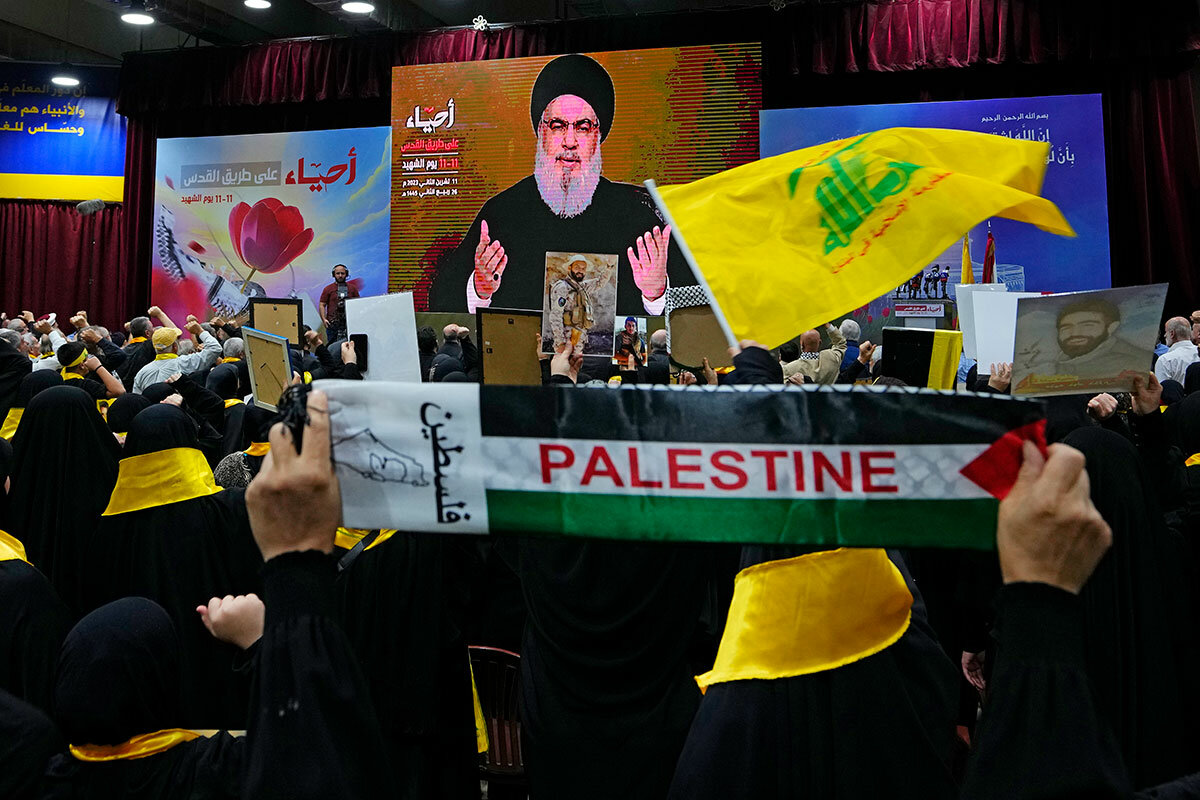
Their message to the Israeli government is clear: Eliminate the threat, even at the risk of a wider conflagration.
“What happened in the south [on Oct. 7] will happen in the north, but just in much greater numbers,” says Doron Shnaper, an aide to Kiryat Shmona’s mayor. “Hezbollah is better armed, better trained, and more capable than Hamas, and they’re sitting 1 meter from Israeli territory.”
Worst fighting since 2006
Northern Israel has known wars and rocket fire for decades. But last month the Israeli government, for the first time, mandated the evacuation of Kiryat Shmona and dozens of other communities in northern Israel due to the threat from Hezbollah. Mr. Shnaper and some 3,000 others have stayed in the city, but the rest of the residents are spread out across Israel, in hundreds of hotels and homes.
The government “told us to prepare for several months,” Mr. Shnaper says.
Much will depend on the duration of the campaign in Gaza, and whether Israel achieves its ambitious goals of eliminating Hamas as a military and governing force in the territory, and recovering some 240 hostages.
Almost immediately after Hamas’ surprise assault, Hezbollah forces, led by their longtime leader Hassan Nasrallah, along with allied Palestinian factions, began attacking Israeli military outposts and communities along the Lebanese frontier with cross-border incursions, anti-tank missiles, rocket and mortar fire, and attack drones. Israel has responded with retaliatory strikes against Hezbollah cells, outposts, and weapons caches.
In the worst bout of fighting between Israel and Hezbollah since their monthlong war in 2006, casualties have mounted on both sides. Eight Israeli soldiers and civilians have been killed, and over a dozen wounded, while Hezbollah has suffered over 70 fatalities.
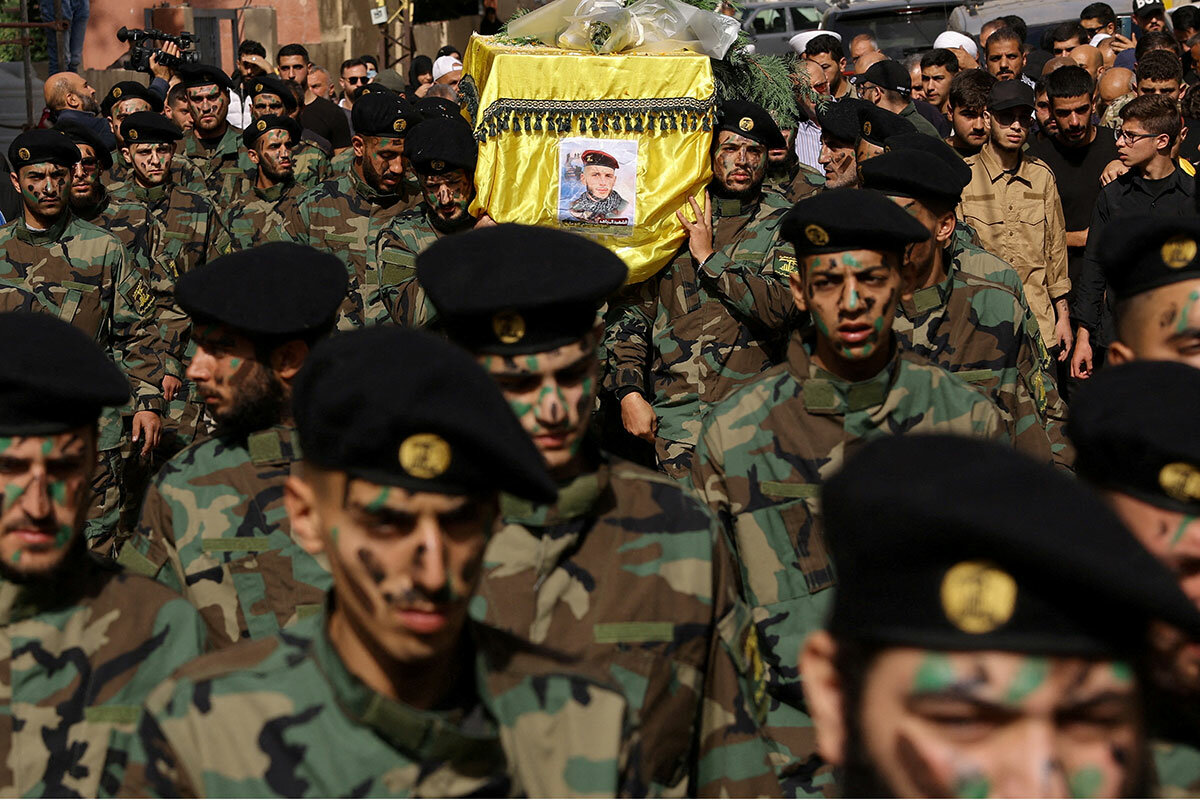
Prime Minister Benjamin Netanyahu, visiting troops in northern Israel this week, said there were “currently exchanges of severe blows” and that the Israeli military had been ordered to “prepare for any scenario.”
“I suggest that Hezbollah not try the State of Israel; it will be the mistake of its life,” he added.
Israeli officials describe their military’s approach as primarily defensive, responding to Hezbollah attacks but not yet going on the attack. The focus, they insist, is on Gaza – at least for now.
This appears to be largely due to pressure by U.S. President Joe Biden on Israel to avoid widening the conflict beyond Gaza. That silenced talk of an Israeli preemptive strike against Hezbollah, an idea reportedly pushed by Israeli Defense Minister Yoav Gallant and some security chiefs.
Israeli decision-makers are also well aware of the destructive capacity of Hezbollah’s rockets and missiles, which far outstrips that of Hamas and other Gaza-based factions.
The Lebanese militia – now termed a “terror army” by Israeli officials and U.S. analysts – is thought to have over 150,000 projectiles in its arsenal, including long-range precision-guided missiles with heavy warheads that can reach targets anywhere in Israel. Israeli officials warn that if it came to all-out war, Hezbollah could rain thousands of rockets and missiles every day on their towns, military bases, power plants, and other installations.
For comparison, Hamas has fired some 10,000 rockets total into Israel in just over 40 days.
“A wicked problem”
Any real war with Hezbollah would extract “a very, very high price,” says Brig. Gen. Assaf Orion, a retired military officer now with the Institute for National Security Studies in Tel Aviv. “And you’re doing this at a less than ideal time in terms of your own force posture, armaments, and preparations,” since the bulk of Israeli ground forces are focused on Gaza.
In lieu of escalation, Israeli leaders have adopted harsh rhetoric and threats to deter Hezbollah. Mr. Gallant this week urged Hezbollah and all Lebanese citizens to learn from the devastation in Gaza, where more than a million people have been forced from their homes. “What we can do in Gaza, we can also do in Beirut,” he said.

Israeli officials believe that for the time being, Mr. Nasrallah is not seeking a broader conflict, and is content to show solidarity with Hamas and pin down Israeli forces – not least because that would provoke severe Israeli retaliation against his own forces. But “this doesn’t mean there won’t be a mistake – by us or them – and a miscalculation” that could lead to escalation, cautions one Israeli official.
Even if the fighting is contained, as it mostly has been so far, to bands of southern Lebanon and northern Israel, the dilemma for Israeli decision-makers will remain: how to enable the return of their citizens to the villages and towns along the Lebanese border if Hezbollah remains in place.
Many in Israel see this not only as a security challenge, but also as a question of sovereignty and Zionism. If two enemies – Hamas and Hezbollah – can oblige whole communities to move, they will have effectively shrunk Israel’s borders.
This has led many analysts and much of the public to see an end to Hezbollah’s presence in southern Lebanon as essential and inevitable, in light of Hamas’ Oct. 7 attack.
“We’re all ready to pay a price now, to let the army deal with this front with a clear head ... so they solve this issue once and for all,” says Mr. Shnaper, from Kiryat Shmona, speaking for many northern residents waiting to return home.
The authorities may seek to resolve the problem through the permanent deployment of more forces on the border and inside communities themselves, so as to improve security. But the risks, along with the threat, will remain.
“At its core,” says Assaf Orion, the brigadier general, “it’s an unstable situation, and a wicked problem.”

Biden and Xi talked for hours. What was accomplished?
The United States and China are trying to avoid conflict, but the recent trend lines have not been good. So when U.S. President Joe Biden and Chinese leader Xi Jinping met in San Francisco yesterday, both seemed eager to find opportunities for progress.
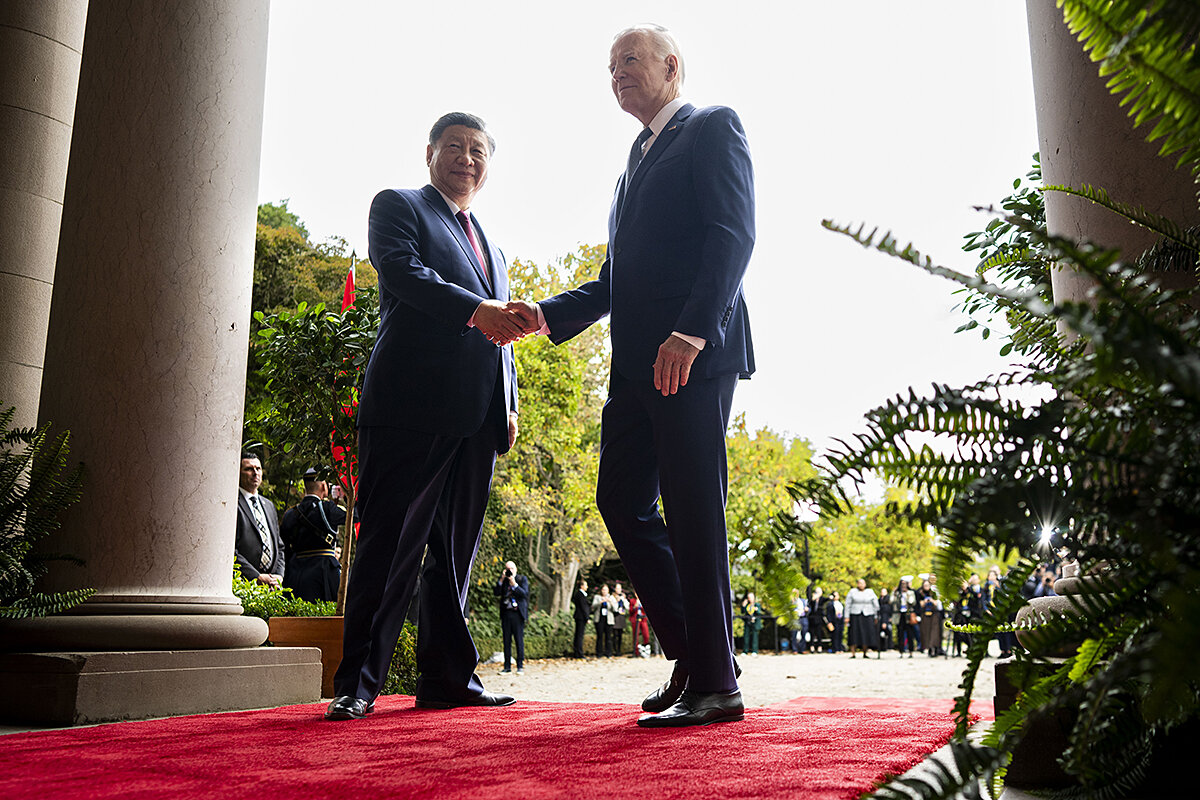
- Quick Read
- Deep Read ( 5 Min. )
President Joe Biden described four hours of talks with Chinese leader Xi Jinping yesterday as “some of the most constructive and productive discussions we’ve had.”
On the sidelines of the Asia-Pacific Economic Cooperation summit in San Francisco, they agreed to reestablish military-to-military contacts, collaborate on reducing illegal fentanyl production, and expand people-to-people ties and direct flights between the two countries. Beyond these specific outcomes, Mr. Biden and Mr. Xi helped broadly establish a new footing for a relationship that has sunk into strife over the past five years.
Yet while reaching concrete agreements and setting out a vision for future cooperation, the leaders framed U.S.-China relations in fundamentally different ways. Mr. Biden cast the relationship as one in which competition and cooperation can take place simultaneously, whereas Mr. Xi said the nations must choose between the two paths.
“If one sees the other side as a primary competitor,” Mr. Xi said during a speech, “it will only lead to ... misguided actions and unwanted results.”
This approach, in part, reflects China’s political culture, says Yun Sun, director of the Stimson Center’s China program. “The Chinese always want [first] to define the relationship – are you my friend or my enemy?” she says, whereas the U.S. approach is more pragmatic.
Biden and Xi talked for hours. What was accomplished?
U.S. President Joe Biden and Chinese leader Xi Jinping agreed on Wednesday to reestablish military-to-military contacts and reaffirmed an open phone line between the commanders in chief – vital steps toward reducing the risk of accidental conflict between the nuclear-armed superpowers.
On another key agenda item for the Biden administration, the leaders said they would cooperate to reduce the flow from China of precursor chemicals used to make the illegal drug fentanyl.
Beyond these specific outcomes, Messrs. Biden and Xi helped broadly establish a new footing for a relationship that has sunk into strife over the past five years, while setting out a vision for future cooperation. The two last met face-to-face in Indonesia a year ago.
Mr. Biden described his four hours of talks with Mr. Xi on the sidelines of the Asia-Pacific Economic Cooperation meeting as “some of the most constructive and productive discussions we’ve had.” Despite areas of disagreement, he said, “we’ve made some important progress.”
Mr. Xi also highlighted headway in the relationship. “We agreed to make the cooperation list longer and the pie of cooperation bigger,” he said in a speech at a welcome dinner hosted by U.S.-China groups in San Francisco Wednesday night.
China’s Ministry of Foreign Affairs summarized the meeting as “positive, comprehensive and constructive,” adding that “San Francisco should be a new starting point for stabilizing US-China relations.”
A shared responsibility
Both leaders stressed that as stewards of the world’s most consequential bilateral relationship, they must – at a minimum – avoid conflict. Competition mustn’t “veer into conflict,” Mr. Biden told Mr. Xi as their talks began. Mr. Xi agreed, saying “conflict and confrontation will have unbearable consequences for both sides.”
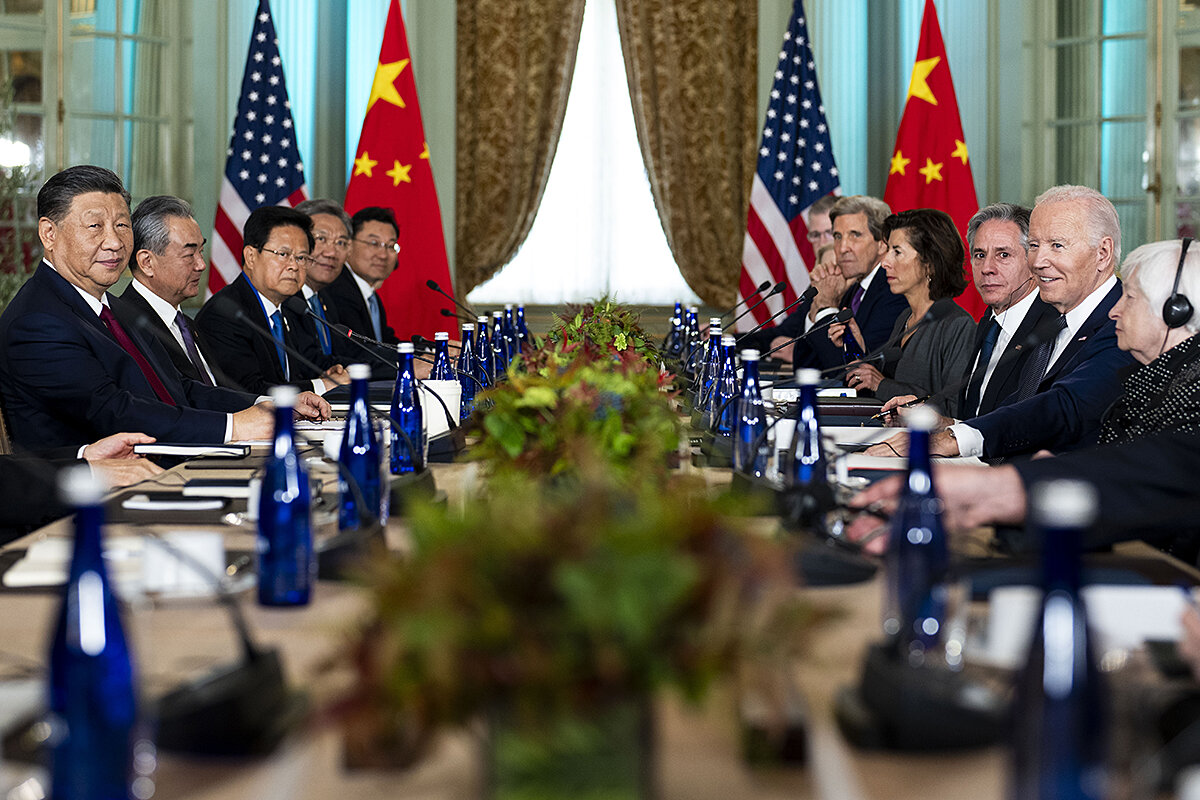
The two men also reiterated that direct communication, including face-to-face and by phone, is paramount to guarding against misunderstandings. Mr. Biden told reporters that he and Mr. Xi agreed that if either one has concerns, “we should pick up the phone and then call one another, and we’ll take the call.”
Yet while reaching concrete agreements and voicing a shared intent, the leaders chose to frame U.S.-China relations in fundamentally different ways. Mr. Biden cast the relationship as one where competition and cooperation can both take place simultaneously, whereas Mr. Xi said their nations must choose between the two paths.
“The No. 1 question for us is: Are we adversaries or partners?” Mr. Xi said in his dinner speech. China, he suggests, wants the latter. “If one sees the other side as a primary competitor ... it will only lead to ... misguided actions and unwanted results,” he said. “China is ready to be a partner and friend of the United States.”
Mr. Xi’s framing in part reflects China’s political culture, says Yun Sun, director of the China Program at the Stimson Center. “The Chinese always want [first] to define the relationship – are you my friend or my enemy?” she says, whereas the U.S. approach is more pragmatic and practical.
Moreover, Mr. Xi’s message is aimed in part at a broader global audience, before which Beijing wants to take the moral high ground of seeking to work together with Washington, says Ms. Sun. “Xi Jinping is making an appeal that the U.S. and China should settle their differences ... because that will be more beneficial to the global community,” she says.
Moments of meaningful progress
The modest but significant deals struck by Messrs. Xi and Biden focus on reducing risk and restoring key channels – with military contacts foremost among these.
The two sides agreed to resume high-level military-to-military communications, defense policy talks, and maritime consultations. They are also “resuming telephone conversations between theater commanders,” the White House said in a statement.
Calls between the U.S. Indo-Pacific Command and China’s Eastern Theater Command could help defuse a crisis in the case of an accident between the U.S. and Chinese militaries, which both operate in the South China and East China seas and the Taiwan Strait, experts say. Yet the potential remains for an unintended run-in.
“Those mil-mil dialogues are important in avoiding unintentional conflicts or accidents ... but the Chinese and the U.S. strategy of flying planes close to one another hasn’t been addressed,” says Dominic Chiu, senior analyst for China and Northeast Asia at Eurasia Group.
China’s agreement to cooperate with the United States on combating illegal drug manufacturing and trafficking, including the synthetic drug fentanyl, is likely to reduce the flow of precursor chemicals and pill presses to drug cartels, Mr. Biden said. The U.S. and China created a working group to coordinate law enforcement efforts on counternarcotics.
“China sympathizes deeply with the American people, especially the young, for the sufferings that fentanyl has inflicted upon them,” Mr. Xi said in his speech.
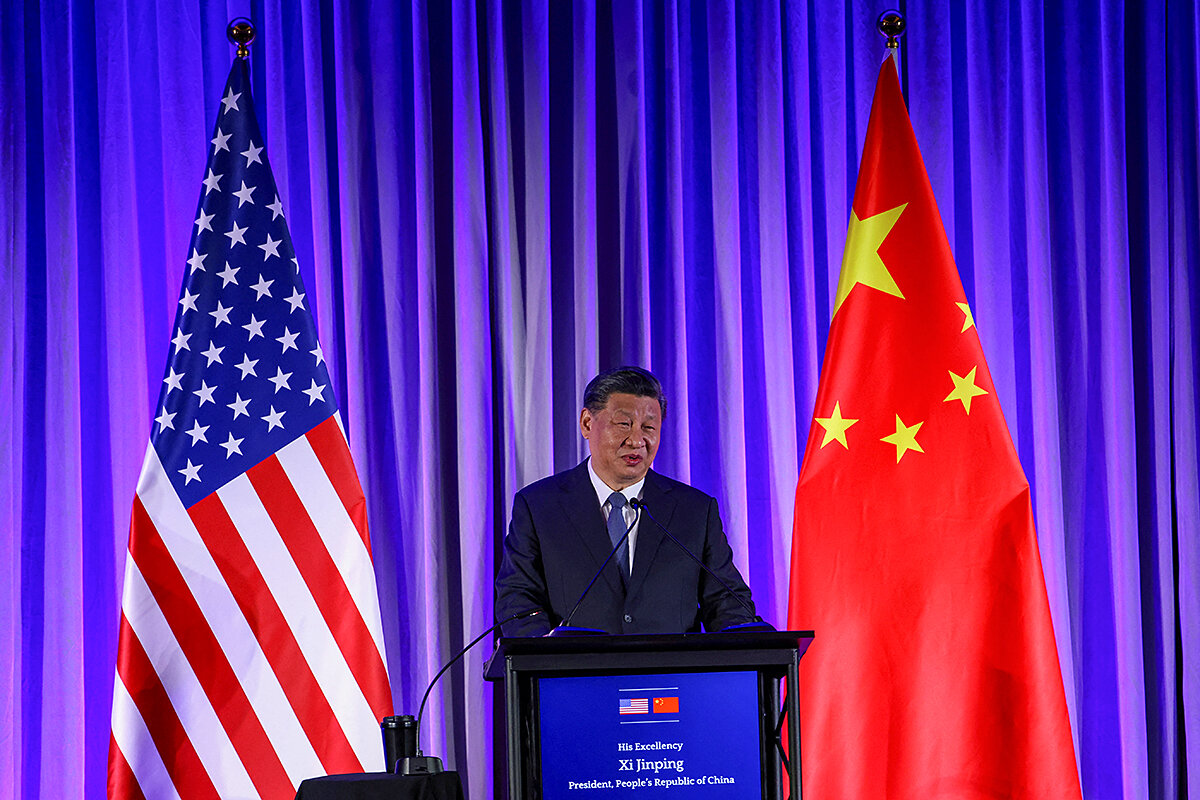
Additional agreements include governmental talks on addressing the risks of advanced artificial intelligence, as well as expanding people-to-people ties and direct flights between the two countries. For example, Mr. Xi pledged that China was ready to invite 50,000 young Americans to attend exchange and study programs in China over the next five years.
Managing disagreements
Both sides acknowledged that China and the U.S. have fundamental differences, including their approaches to Taiwan, a top priority issue for Beijing.
Mr. Xi asked Mr. Biden to stop arming Taiwan and to support China’s “peaceful reunification” with the democratic island, which China’s Communist Party-led government claims as part of its territory. In turn, Mr. Biden reiterated Washington’s support for the “one China” policy, which recognizes Beijing’s stance. He also called on China to show restraint in its military activity around Taiwan, which has sharply increased in recent years.
Overall on Taiwan, and other areas of disagreement, “both leaders wanted to put their best foot forward without making any concessions,” says Andrew Scobell, a distinguished fellow with the China program at the U.S. Institute of Peace.
Mr. Biden raised U.S. concerns over thorny issues such as China’s human rights violations and detention of U.S. citizens, as well as its “coercive activities” in the South China Sea. At Wednesday’s press conference, he said straight talk – “just being blunt with one another so there’s no misunderstanding” – is useful.
Taking the long view, Mr. Xi told Mr. Biden at the onset of their meeting that the “China-U.S. relationship has never been smooth sailing. ... Yet, it has kept moving forward amid twists and turns. For two large countries like China and the United States, turning their back on each other is not an option.”

Patterns
Israel, Ukraine race against time as world patience thins
The wars in Gaza and Ukraine have very different dynamics, but they share at least one similarity: the importance of time. The longer the wars last, the more Hamas and Russia would seem to gain. That fact is driving how both wars are being waged.

- Quick Read
- Deep Read ( 4 Min. )
Which world leader recently said the following?
“Freezing the war, to me, means losing it.”
Those words, spoken to Time magazine, go to the heart of why Israeli Prime Minister Benjamin Netanyahu has been resisting international pressure to halt the fighting in Gaza.
But it was not Mr. Netanyahu who said them. It was Ukrainian President Volodymyr Zelenskyy.
For while these two very different leaders are fighting two very different wars, they face a strikingly similar political challenge. They are fighting against the clock.
Israel is under growing pressure from the United States, among many other countries, to pause its military ground offensive in Gaza. Mr. Netanyahu is refusing to take any step that might turn into a cease-fire. But with the Palestinian death toll at 11,000 and rising, he cannot do that indefinitely.
Mr. Zelenskyy has a different problem. He fears that as world attention turns to Gaza, his cause becomes less popular. One sign that time might be running out is a growing reluctance among Republican legislators in Washington to keep arming Ukraine.
Mr. Netanyahu wishes that the outside world would stop looking so closely at Gaza and judging Israel so harshly. Mr. Zelenskyy yearns for the opposite.
He hopes that the world will keep paying him attention.
Israel, Ukraine race against time as world patience thins

“Freezing the war, to me, means losing it.”
Those words, spoken to Time magazine, go to the heart of why Israeli Prime Minister Benjamin Netanyahu has been resisting international pressure to call a halt to the fighting in Gaza.
But it was not Mr. Netanyahu who said them. It was Ukrainian President Volodymyr Zelenskyy.
For while these two very different leaders are fighting two very different wars, they face a strikingly similar political challenge.
Each has vowed to defeat an enemy that explicitly rejects their country’s right to exist. But they know that other countries, including key allies, are making judgements of their own about how these wars are fought, for how long, and how they might end.
The result is that Israel and Ukraine are not just fighting Hamas or Russia.
They are also fighting the clock. They are fighting what might be called “stopwatch wars.”
And to the frustration of Prime Minister Netanyahu and President Zelenskyy, Hamas and the Kremlin are both calculating that time is on their side – that merely by denying the other side its existential victory, they will come out on top.
They know that for Ukraine and Israel, “freezing the war means losing it.”
Still, what happens next – when and whether the stopwatch intervenes – will depend on complex, and quite different, sets of circumstances in Gaza and Ukraine.
For Israel, the international pressure is more immediate.
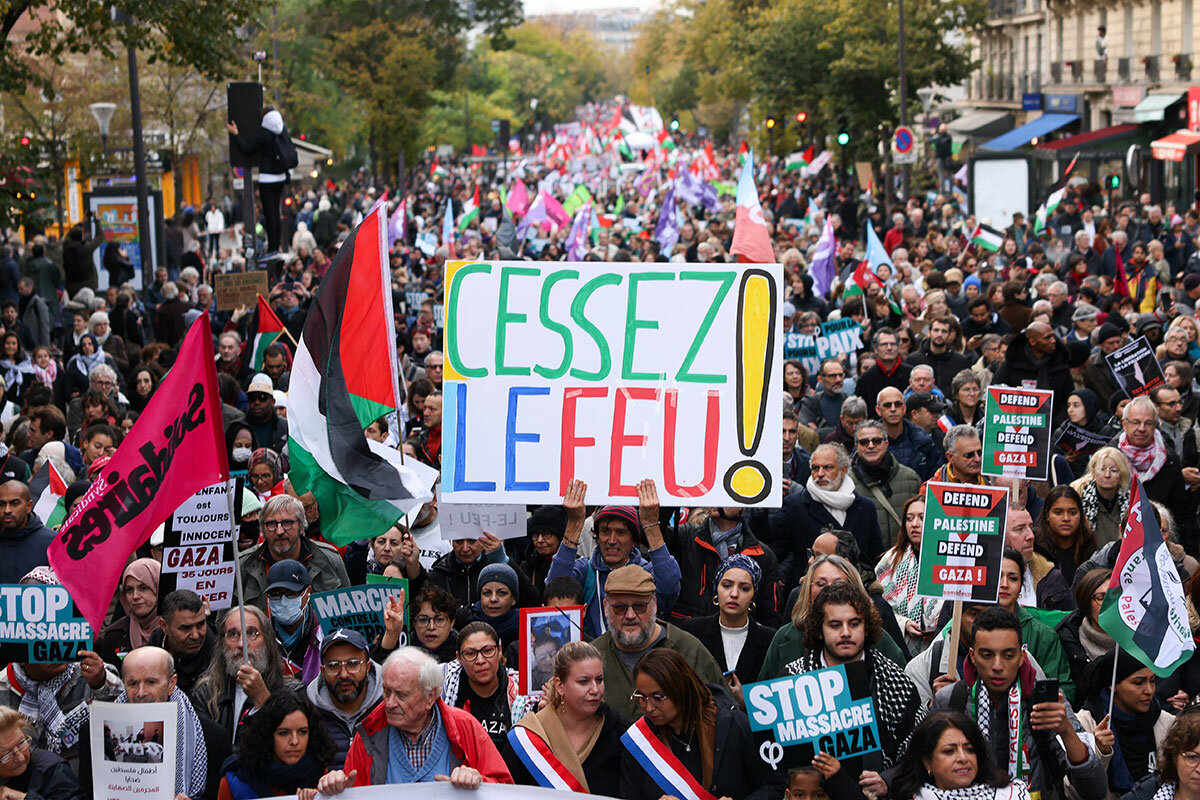
Israel’s allies, and many other governments worldwide, do not challenge Israel’s right to defend itself in the wake of the savage Hamas attack on Oct. 7 that left an estimated 1,200 people dead and dozens more taken hostage. They understand the Israeli government’s desire to crush Hamas.
But the scale of destruction that the Israeli attacks have brought to Gaza – and above all, the reports and images of civilian suffering – has alarmed even Israel’s closest friends.
The United Nations and international nongovernmental organizations have been calling for a cease-fire.
And with the death toll climbing above 11,000, the United States and other allies have insisted on the need to protect civilians and greatly increase supplies of vital aid. They’ve urged a “humanitarian pause” to accomplish this, and to facilitate a hostage deal.
Two Western leaders, French President Emmanuel Macron and Canadian Prime Minister Justin Trudeau, went further this week, saying “women, children, and babies” were being killed, and that this had to “stop.”
Still, at least for now, Mr. Netanyahu seems likely to resist expanding any “pause” into a full-scale cease-fire.
That may be partly because of personal political calculations. With most Israelis blaming him for allowing the Hamas surprise attack, he is determined to restore his image as “Mr. Security” in hopes of remaining in office.
But with the trauma of Oct. 7 still fresh in their minds, most Israelis back the military’s attempt to break Hamas’ hold on Gaza. The generals feel that is critical to restoring Israel’s badly tarnished regional deterrence.
Even if the fighting continues, however, the stopwatch is ticking on a political issue that Mr. Netanyahu may find harder to finesse: the need, voiced by U.S. President Joe Biden and the wider international community, to engage in serious postwar diplomacy on a peace treaty with the Palestinians that will give them a sovereign state.
For President Zelenskyy, the pressure of the stopwatch is no less daunting, yet different.
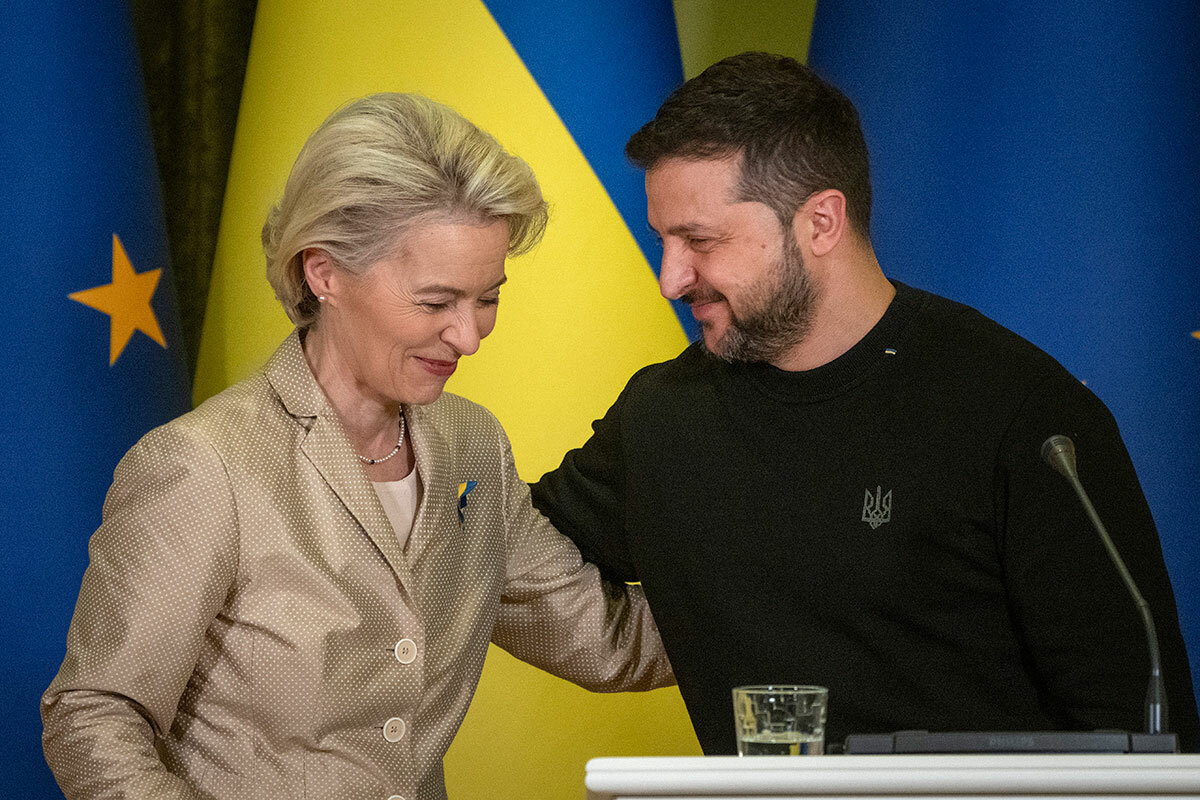
Ukraine stunned not just Washington and other allies, but the Kremlin, too, by turning back the Russian invasion in February 2022. Then the Ukrainians drove Russian forces back in the east of the country and prepared for what they had hoped would be a wider counteroffensive.
All this was made possible by large-scale deliveries of arms and equipment from the U.S. and Europe.
But Mr. Biden has been determined to avoid direct confrontation with Russia, and that has meant that Ukraine’s allies have sent enough weapons to stave off defeat, but not enough to drive the invading forces back into Russia.
Now, officials in Kyiv fear even that support could be weakening. One sign that worries them is a growing reluctance among some Republican legislators in Washington to keep arming Ukraine.
And there was an inadvertent signal this month that the slippage may be wider.
Italian Prime Minister Giorgia Meloni – duped by Russian pranksters pretending to be African diplomats – said that “there is a lot of fatigue” among Ukraine’s allies. “We are near the moment when everybody understands that we need a [diplomatic] way out,” she added.
For Mr. Zelenskyy, that comment could not have come as a surprise. “The scariest thing,” he told Time, “is that part of the world got used to the war in Ukraine.” A kind of “exhaustion” had set in, he said.
And though he has made clear that his sympathies lie with Israel after Oct. 7, he knows that the world’s focus on Gaza risks exacerbating that exhaustion.
While Mr. Netanyahu clearly wishes that the outside world would stop looking so closely at Gaza, and judging Israel so harshly, Mr. Zelenskyy yearns for the opposite.
He hopes that the world will keep paying him attention.

Difference-maker
How WriteGirl helps teens find their creative voice
And for a change of pace as we finish today, we look at how one woman is trying to flip the script on outdated gender roles. Girls used to be told to be seen and not heard. Keren Taylor founded WriteGirl to inspire them to see their voice as valuable.

- Quick Read
- Deep Read ( 5 Min. )
-
By Dua Anjum Contributor
A rainy afternoon is perfectly conducive to a poetry reading. Sansa, age 15, shares “Venice Beach” – the first poem she ever wrote. “The ocean knows nothing lasts forever,” she reads, leaving goose bumps across the room.
Sansa says she’s been writing for eight years and has been working on her own trilogy for the past four. But when writers block hit, she longed for a writing community. That’s when she found WriteGirl.
Keren Taylor started WriteGirl in 2001 as a way to help teen girls who did not have access to creative writing programs. Today, 400 women writers volunteer with 700 teenagers a year. Since the pandemic, the nonprofit, which began in Los Angeles, has shifted to a virtual model that allows teens from 18 countries to participate. Ms. Taylor says it’s been exciting to have girls joining from Nigeria, Poland, Tajikistan, Uganda, and Kenya.
“Teen girls are still incredibly vulnerable and invisible, and that contributes to a real deep sense of loss of self-worth,” Ms. Taylor says. “I just feel like they’re a really important group for us to lift up and help and inspire.”
How WriteGirl helps teens find their creative voice
A rainy afternoon is perfectly conducive to a poetry reading. Teens step to the stage to share their words and their hearts at a literary event hosted by WriteGirl held at the Downey City Library in California. The girls read short poems, list poems, angry poems, sad poems, and nature poems. Sansa, 15, shares “Venice Beach” – the first poem she ever wrote. “The ocean knows nothing lasts forever,” she reads, leaving goose bumps across the room.
Sansa lives in Marina del Rey and calls Draco Malfoy fan fiction her first writing experience. She says she’s been writing for eight years and has been working on her own trilogy for the past four. Suffering writer’s block, she searched for writing groups in Los Angeles, looking for community. When she found WriteGirl, she was inspired. “I’m getting to share my work in front of people. Yes, it’s nerve-wracking, but I think it’s absolutely worth it,” says the teen. None of the teenage writers’ last names are being used to protect their privacy.
Keren Taylor started WriteGirl in 2001 as a way to help teen girls who did not have access to creative writing programs. “Teen girls are still incredibly vulnerable and invisible, and that contributes to a real deep sense of loss of self-worth,” Ms. Taylor says. “I just feel like they’re a really important group for us to lift up and help and inspire.”
Today, 400 women writers volunteer with 700 teenagers a year, and the nonprofit has expanded beyond its LA roots. Every girl who has gone through the mentorship program has gone on to college – and several to careers as professional writers. It works with boys and co-ed groups under the name Bold Ink. The group’s most famous alum is Amanda Gorman, who became a literary star after reading her poem “The Hill We Climb” at President Joe Biden’s inauguration.
Through the free program, girls dive into poetry, fiction, songwriting, journalism, screenwriting, journal writing, and editing, learning techniques from a network of professional women writers. If needed, the girls also receive support with their college applications. The group’s anthologies have also won 99 literary awards, and in 2013, the organization won a National Arts and Humanities Youth Program Award.
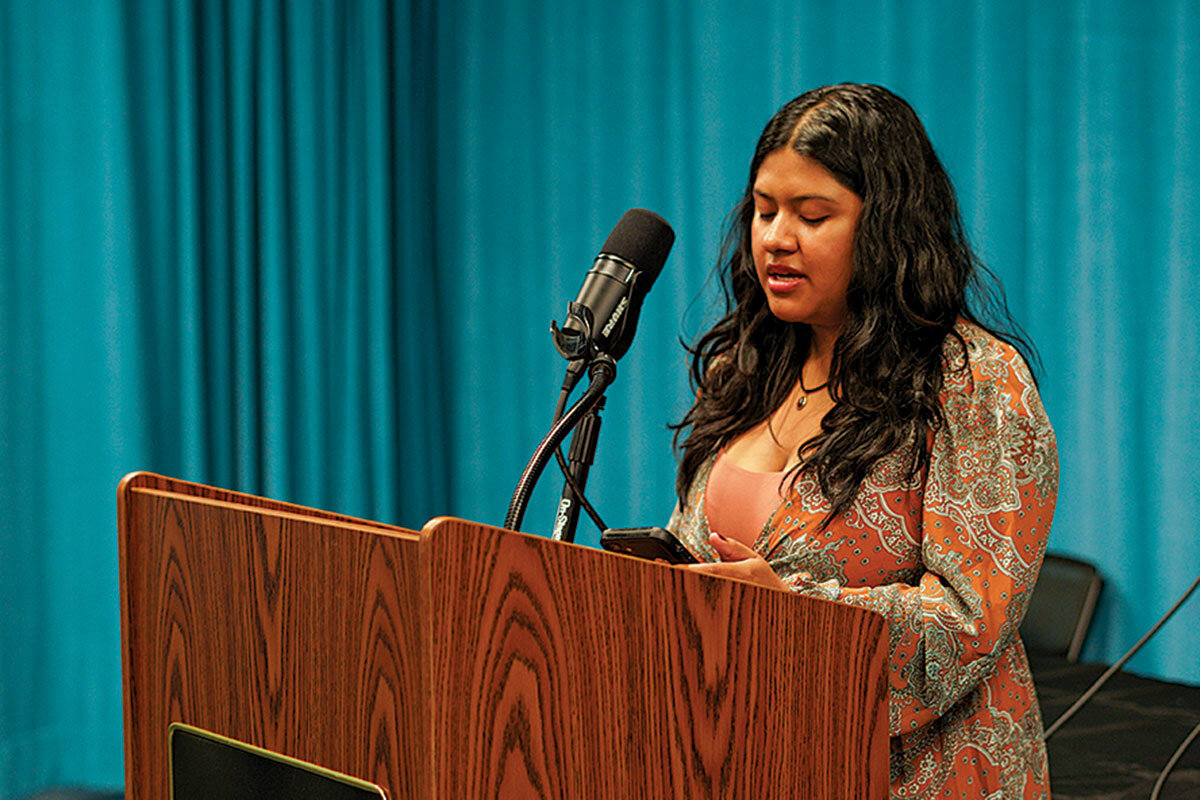
Getting on her Soapbox
For JG, a 15-year-old who goes to school in Studio City and loves speech, debate, and martial arts, the Soapbox segment of the Writing Wednesdays workshop was part of what convinced her she’d found her people. During that time, girls are invited to “rant or rave” on a topic of their choosing for 30 seconds.
“I felt so connected to the community. We share this bond of writing,” says JG, who began attending online workshops last year.
JG has been working with her mentor, Danyella Wilder, for about a year – with weekly meetings via Zoom during which they experiment with writing exercises, share their words, or simply talk. Ms. Wilder and JG say that the mentorship has not only allowed them to explore a variety of genres but also contributed to their personal growth. “With WriteGirl, I’ve developed a lot of confidence in being able to put my voice on paper,” JG says.
Mentoring JG reminds Ms. Wilder, a writer and editor, why she first fell in love with writing herself. She says the long-term nature of the mentoring was what drew her in. “It almost seems like she’s like a little sister of mine. I like to say [there is] friendship, too. I just feel like we get to giggle and we get to laugh with each other about things.” She wishes she had a program like this herself when she was 15. “To just have an organization where there are people who are spending time out of their day just to tell you, ‘Hey, good job,’ or ‘That was amazing,’ you’re at the age where you need to hear that.”
In August, WriteGirl received the Creative Recovery LA grant from the Los Angeles County Department of Arts and Culture. “We’re really proud to have been able to support them because of the incredible work that they do to support young people and girls ... to help them with creative expression and especially those who are systems impacted, who may be really deeply connected in the foster system or the justice system,” says director Kristin Sakoda.
The department has also worked with WriteGirl for the past five years as part of the Arts for Healing and Justice Network, the only arts collaborative for incarcerated youth in California. “It’s wonderful to have some organizations that really focus on young people but also focus on girls and girls’ empowerment,” Ms. Sakoda says.
Since the pandemic, the nonprofit has shifted to a virtual model that allows teens from 18 countries to participate. Ms. Taylor says it’s been exciting to have girls joining from Nigeria, Poland, Tajikistan, Uganda, and Kenya.

Joining in from overseas
When Ms. Gorman read her work at President Biden’s inauguration, Mariana’s mom read about it – and WriteGirl – in Uruguay. She told her daughter about WriteGirl’s online workshops. In the spring of 2021, Mariana started attending workshops over Zoom. “It’s a really, really safe space,” Mariana says. “Some stuff that maybe I wouldn’t share with my friends at school, I would definitely share in a workshop.” She requested a mentor and in 2022 started working with Myrna Aguilar.
Mariana, now a sophomore in high school, has since moved to North Carolina with her family. Her poem “The Future” (inspired by the song “AA” by The Neighbourhood Watch) was recently published in WriteGirl’s latest anthology in both Spanish and English. “I’ve always loved writing, but I’d never done poems,” she says. “If I wasn’t in WriteGirl, I probably wouldn’t have written some of the poems that I love the most.”
Nicole Jefferson started as a mentee in 2016 during her junior year of high school in Los Angeles and credits WriteGirl with helping her with not only her college essay but also the whole application process. She ended up going to Yale.
After graduating in 2022, she volunteered as a mentor. “WriteGirl takes the pressure off, and there’s no right or wrong. You just kind of throw yourself into it. And I think that there’s a lot to be said about the vulnerability and pure joy and little bit of chaos that can come from it,” she says.
After completing a one-year mentorship, Ms. Jefferson recently moved to Dublin, Ireland, for graduate school. “I ended up making some really lovely friends at WriteGirl,” Ms. Jefferson says. “Actually, one of my friends from WriteGirl ended up going to Yale with me. She’s amazing. I love her.”
Ms. Taylor has seen firsthand how people develop long-lasting relationships. “We only ask a mentor to join for a year, but we hope that they will enjoy working together and keep going,” she says. “They often end up becoming very close. Friends and mentors have gone to the teen’s graduation from high school, graduation from college, their weddings.”
Other headline stories we’re watching
(Get live updates throughout the day.)The Monitor's View
Returning Afghans bring dignity home
- Quick Read
- Deep Read ( 3 Min. )
-
By the Monitor's Editorial Board
Pakistan has begun deporting hundreds of thousands of Afghan migrants and refugees in response, it claims, to an uptick in extremist violence. Meeting their immediate basic needs in Afghanistan will be a challenge. Few facilities are in place to care for them, and Pakistani authorities have imposed severe limits on what they can take with them.
If the returnees are light of possessions, however, they bring expectations that the Taliban may find increasingly difficult to dismiss. They include women of diverse educational backgrounds and occupations who are unlikely to submit quietly to the Taliban’s stern strictures governing what they can and cannot do.
They are part of a generation demanding equality and democratic reform in an arc of Muslim countries stretching from Pakistan to Sudan. In gestures large and small, they are resisting regimes that have sought to order their societies on the basis of strict religious creeds.
Authoritarian regimes seldom face a mass return of their people. Now the Taliban do. In their defense of dignity and demand for equality, returning Afghans are bringing home a lesson in the true substance of power.
Returning Afghans bring dignity home

Pakistan in recent weeks has begun deporting hundreds of thousands of Afghan migrants and refugees in response, it claims, to an uptick in extremist violence. Security analysts see an unfolding humanitarian crisis and warn of wider insecurity in an already fragile region. “Afghan authorities are ill prepared to receive massive numbers of returnees,” the International Crisis Group observed on Monday.
An estimated 4 million Afghans live in Pakistan. Many fled war or – more recently – harsh social and economic restrictions reimposed by the Taliban following their return to power two years ago. Many more were born there. As many as half now face expulsion. Meeting their immediate basic needs in Afghanistan will be a challenge. Few facilities are in place to care for them, and Pakistani authorities have imposed severe limits on what they can take with them.
If the returnees are light of possessions, however, they bring expectations that the Taliban may find increasingly difficult to dismiss. They include women of diverse educational backgrounds and occupations who are unlikely to submit quietly to the Taliban’s stern strictures governing what they can and cannot do. As one migrant, Bibi Gul, told Radio Free Europe at a border crossing, her family fled Afghanistan “because my daughter was deprived of an education. Now that we have returned, she must be able to continue her studies.”
Women like Ms. Gul are part of a generation demanding equality and democratic reform in an arc of Muslim countries stretching from Pakistan to Sudan. In gestures large and small, they are resisting regimes that have sought to order their societies on the basis of strict religious creeds. One measure of their resonance is evident in the way that Iranians view the resurgent conflict between Israelis and Palestinians in Gaza.
“In an increasingly secular Iranian society it is hard to argue, as the regime and those who support it would like to, that one should support Palestinians solely because they are Muslims,” Najmeh Bozorgmehr, an Iranian journalist based in Tehran, wrote this week in the Financial Times. “‘I don’t care about each side’s religion. I care about humanity,’” a taxi driver told her recently.
When the Taliban returned to power in Afghanistan in August 2021, their promises to rule moderately were short-lived. They banned education for girls after the age of 12. Women who work outside the home must be accompanied by men. Females must be fully covered in public.
Those measures stirred women to protest under the slogan “Bread, Work, Freedom” – reflecting their diversity as teachers, mothers, entrepreneurs, and former government officials. More than once, the Taliban have had to back down. Earlier this year they lifted a ban on female foreign aid workers. They raised the education limit to the 14th grade for girls in religious schools.
“Despite all the unfairness, oppression, injustice and difficulties I keep going on,” a young woman who was studying physics at Jawzjan University wrote on a United Nations website where Afghan women can share their stories of life under the Taliban. “I want to be a changemaker. ... We still have hope.”
Authoritarian regimes seldom face a mass return of their people. Now the Taliban do. In their defense of dignity and demand for equality, returning Afghans are bringing home a lesson in the true substance of power.

A Christian Science Perspective
Each weekday, the Monitor includes one clearly labeled religious article offering spiritual insight on contemporary issues, including the news. The publication – in its various forms – is produced for anyone who cares about the progress of the human endeavor around the world and seeks news reported with compassion, intelligence, and an essentially constructive lens. For many, that caring has religious roots. For many, it does not. The Monitor has always embraced both audiences. The Monitor is owned by a church – The First Church of Christ, Scientist, in Boston – whose founder was concerned with both the state of the world and the quality of available news.
The energizing influence of praising God
- Quick Read
- Read or Listen ( 3 Min. )
-
By Kim Crooks Korinek
Praising God as the source of all good is something we can do daily, and in doing so, we will realize greater peace, health, and harmony.
The energizing influence of praising God
Gratitude can be such a gentle, humble thing. And as we practice gratitude, it can grow into a protecting, guiding, and multiplying influence. Giving gratitude is an act that requires slowing down, silencing the mental chatter, and paying attention. Although gratitude may start with being grateful for things and circumstances, as our gratitude deepens and broadens, it becomes praise to God as the ultimate source of good.
God is good. All good. The source of all life, all truth, and love. In Christian Science, we follow Christ Jesus’ teachings about God and praise and acknowledge God as all-inclusive, all-loving, “with whom is no variableness, neither shadow of turning” (James 1:17).
God gives us a sense of peace and belonging, protection and refuge, and hope, healing, and joy – an underlying spiritual reality and eternal home base. As we explore the depths of what infinite God has given, we find that good naturally multiplies.
• Like a rock, praise becomes the foundation for our health and our peace. When we praise our Father-Mother God for Her goodness, we are witnesses to God, and our feet are planted firmly in our acknowledgment of God. “The Lord liveth; and blessed be my rock; and let the God of my salvation be exalted” (Psalms 18:46).
• Praise opens our thinking to recognize more of God as the one creator, and each of us as God’s creation. And because the nature of the creator is to create, creation is always unfolding, with God, divine Mind, as the multiplier, giving us boundless opportunities, resources, and ideas. “I will sing unto the Lord, because he hath dealt bountifully with me” (Psalms 13:6).
• Like a shield, praise purifies and protects our thoughts and actions. Thoughts of God – Truth, Life, and Love – wash us clean. Thoughts of God are like light that chases away all darkness. Nothing evil can enter the thought that is overflowing with praise for God. We “should shew forth the praises of him who hath called [us] out of darkness into his marvellous light” (I Peter 2:9).
• Praise for God breaks through the mesmerism of fear and lack and reveals that God is all-powerful divine Love and ever-active divine Truth. Justice and mercy are inevitable. We need never despair. “Why am I discouraged? Why is my heart so sad? I will put my hope in God! I will praise him again—my Savior and my God!” (Psalms 42:5, 6, New Living Translation).
• Praise heals. A consciousness of God’s goodness transforms our lives from limitation to abundance; from sickness to health. “I shall yet praise him, who is the health of my countenance, and my God” (Psalms 42:11).
I’ll never forget how praise for God proved these statements to be true in my life. When our children were young, my husband and I were notified of an upcoming job layoff. We resolved to praise God every night and only let gratitude fill our thoughts. This helped us see that for all the good our family had experienced, there was a consistent spiritual law at work that had guided us through every step, and it would guide us through our next steps.
This put a halt to any fear, reactive outlining, or anxiety. Continued, confident praise for God led us to understand that nothing could stop God’s law of progress for our family or for anyone’s family. And as we were listening, grateful for the full provision of the good we had, we trusted that God’s perfect care would continue.
Our prayer of praise led to a readiness and a calm trust to do things a little out of the ordinary. When the layoff came, we were quickly able to move across the country to a new home, and we found innovative opportunities for each of us to grow in surprising ways that enriched all our lives. But most importantly, we were profoundly moved to know God’s love and care even more. And through that bright communion with Love, I was inspired to start my full-time healing practice of Christian Science.
The “Manual of The Mother Church” by Mary Baker Eddy, who discovered Christian Science, says, “Gratitude and love should abide in every heart each day of all the years” (p. 60). Daily gratitude shifts human consciousness from being self-centered to God-centered, opening our eyes to infinite possibilities that God continually pours out to us. Our gratitude and praise for God bring a richness and confidence we all can feel every day.

Viewfinder
Moving forward
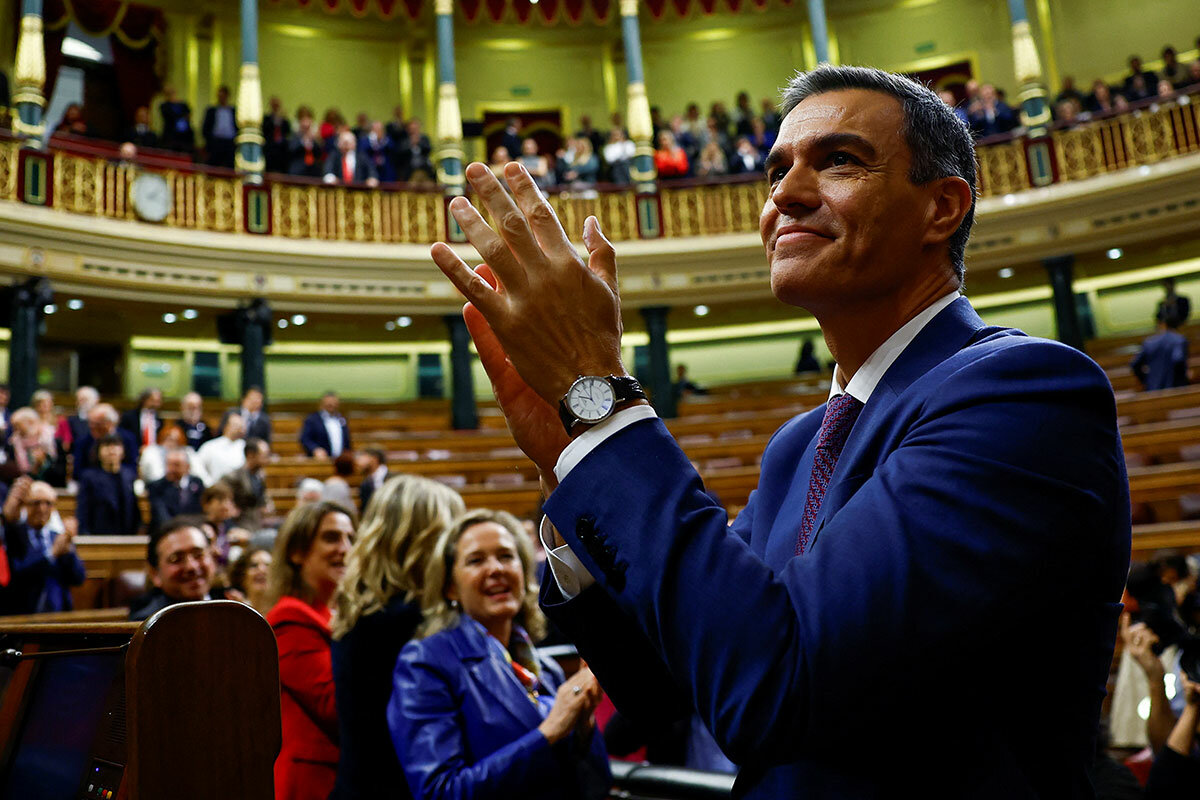
A look ahead
Thank you for coming along today. Please come back tomorrow for a look at how New York City’s migrant influx has changed Eric Adams’ mayorship in unexpected ways.
And remember to drop us a line at editor@csmonitor.com if you have any thoughts on our new, shorter intros, and slightly more in-depth editor’s notes above each story.


